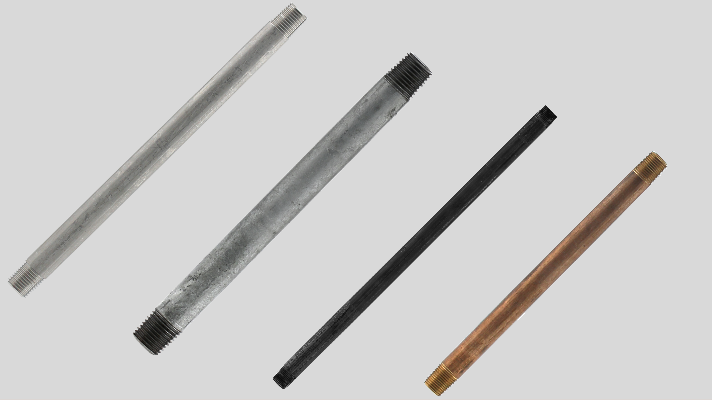There was a little while when, polybutylene was a popular plastic piping material used for water supply. It seemed that polybutylene was a good substitute for copper until failures and leaks were found in the plastic.
In this blog post, we will dive into the the issues with polybutylene, how to identify it and cover repairing and transitioning from existing polybutylene to approved piping systems. 
Image taken from http://jshomeinspect.blogspot.com/2015/01/pb-versus-pex-piping.html
For 20 years between 1975 to 1995, polybutylene was used in residential plumbing systems as a replacement for copper piping. This plastic pipe was inexpensive to manufacture, flexible and easy to install, so it was called the "pipe of the future".
The issues with polybutylene
Manufacturing of polybutylene stopped in 1996 after reports that the pipe was bursting and causing property damage. There were many lawsuits and a class action settlement filed over Polybutylene pipe in the 80's & 90's.
A study, conducted by the University of Illinois, was published and showed that certain chemicals, including chlorine, react with polybutylene piping and make the fittings brittle, flake apart and erode. According to the paper published, small cracks can become deeper and over time cause fractures deep enough for water to escape.
There aren't currently any regulations that state polybutylene piping has to be replaced, however some insurance companies charge a premium, refuse to insure or require the system to be replaced with a different type of pipe. The deterioration happens within the pipe so there is no way to test for weaknesses within the pipe. Many plumbers recommend being proactive and switching away from polybutylene for that very reason.
Identifying polybutylene pipe

Typically Polybutylene is usually 1/2" or 1" grey pipe, but it can be blue, black, white or silver. On the pipe there is a “PB2110” marking. Not to be confused with PEX pipe, polybutylene pipe is less flexible and does not have as high of a temperature rating.
Polybutylene piping is generally grey when found inside the house. It can often be found by water heaters, sinks and toilets, inside walls and along ceilings in basements. When found outside the house, polybutylene can usually be found entering though a basement wall to the water meter or the main water shut-off valve and is more often blue.
Image taken from https://www.nachi.org/pb.htm
Replacing polybutylene pipe
A licensed plumber should be called to replace an entire polybutylene system. They will be able to help provide an estimate and have a better idea of what is involved to replace the polybutylene piping as some piping might be behind finished walls. That being said, if small repairs are needed or to transition to new piping is needed, transition couplings can be used. For example, if a new appliance is being added to the system.
When replacing polybutylene pipe, PEX pipe is a great replacement option. It is tougher, more durable, can withstand high temperatures, maintains great flexibility and has a long lifespan. That being said, other pipe including copper and CPVC can be used.
Two types of transition couplings:
 Crimp type PB transition coupling. This coupling has two barbed ends manufactured to two standards. One end, ASTM-F1807, inserts into the polybutylene pipe, PB2110, and the other ASTM-F876, inserts into PEX pipe, ASTM-F877. Polybutylene has a larger inside diameter then PEX, which is why a special coupling is required.
Crimp type PB transition coupling. This coupling has two barbed ends manufactured to two standards. One end, ASTM-F1807, inserts into the polybutylene pipe, PB2110, and the other ASTM-F876, inserts into PEX pipe, ASTM-F877. Polybutylene has a larger inside diameter then PEX, which is why a special coupling is required.
Either copper crimp rings or stainless steel pinch clamps can be used to make the connection by sealing the inside diameter of the pipe to the fitting using a special crimping tool. The same clamps can be used on both the polybutylene pipe and the PEX pipe as they both have the same outide diameter.


The PB transition coupling is sold as a kit complete with the stainless steel pinch clamps (shown in the pictures above). You can use the copper crimp rings (shown below) if desired. 

 Brass Push Fit PB Transition Coupling. Similar to the fitting above, it has a special end for the polybutylene pipe coloured blue for easy identification. One end, the blue end, connects to polybutylene pipe, PB2110, and the other end a CTS (copper tube size) connection, ASSE 1061, allowing for copper pipe, CPVC and PEX piping to be used.
Brass Push Fit PB Transition Coupling. Similar to the fitting above, it has a special end for the polybutylene pipe coloured blue for easy identification. One end, the blue end, connects to polybutylene pipe, PB2110, and the other end a CTS (copper tube size) connection, ASSE 1061, allowing for copper pipe, CPVC and PEX piping to be used.
These push fit fittings don't require any specialized tools making them easy to install. The Polybutylene end of the transition coupling has a larger diameter insert or stiffener to support the thinner wall polybutylene pipe.

Even though polybutylene pipe was once "the pipe of the future", it has become clear that there were flaws with it. Being aware of the risks and reasons why polybutylene pipe is no longer used can help identify pipe and determine if replacement is required. A small leak can lead to more damage in the future so being aware about it now can help down the road, thankfully there are transition couplings to help you out!

.jpg)

-1.png)
SHARE